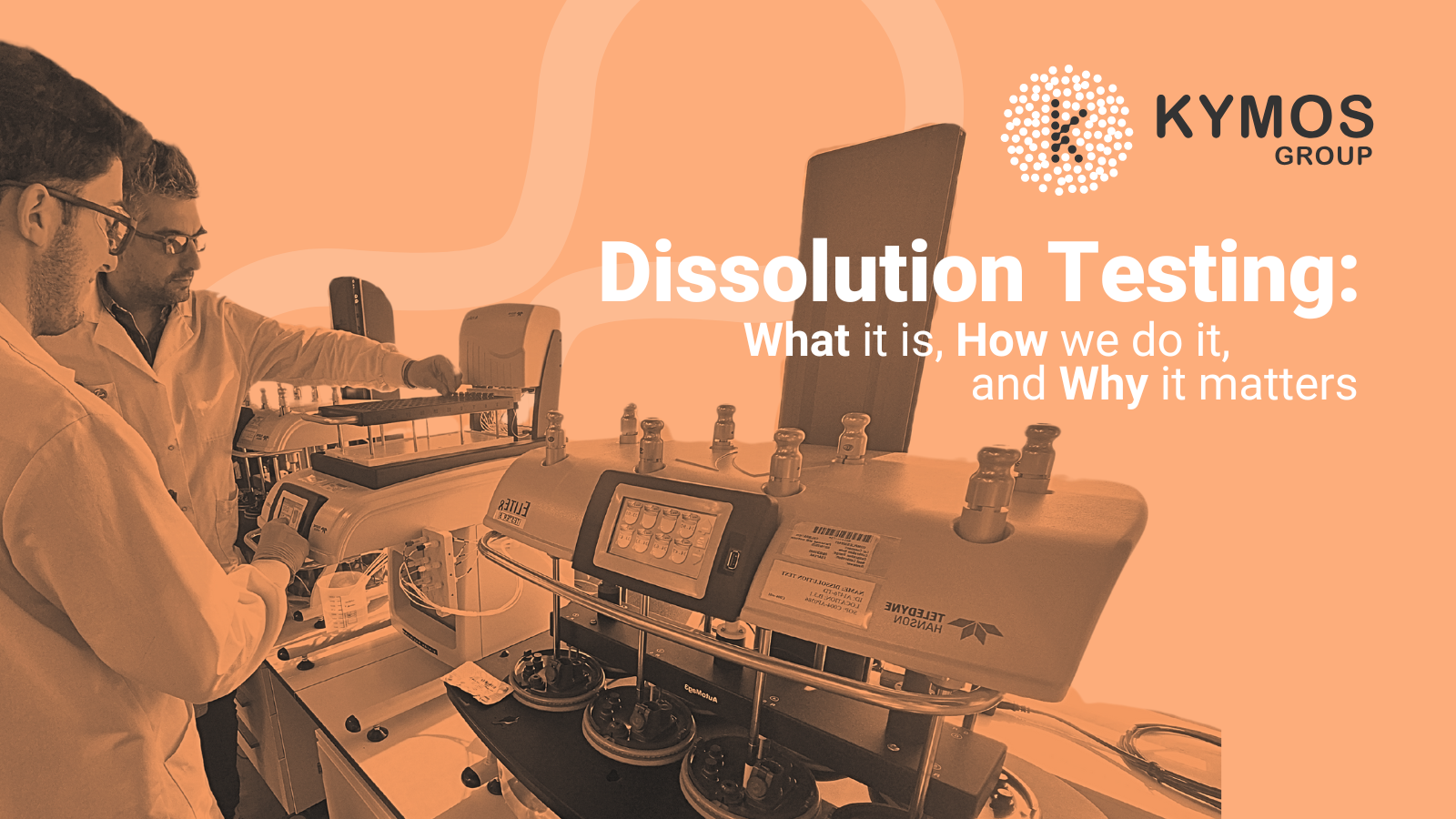
Dissolution testing is a fundamental analytical technique in the pharmaceutical industry, providing information on how a drug is released from its dosage form. This analysis is vital for ensuring product quality, predicting performance in vivo, and meeting regulatory requirements.
At Kymos Group, we are experts and count with years of experience in dissolution testing, offering a comprehensive suite of services that includes both compendial methods and tailored solutions for more complex drug delivery systems like transdermal patches. In this article, we’ll explore the various dissolution apparatus described in international pharmacopoeias and detail how we leverage our expertise and state-of-the-art equipment to support your pharmaceutical development needs.
What is Dissolution Testing and Why is it Essential?
Dissolution testing measures the rate and extent to which an active pharmaceutical ingredient (API) is released from a solid or semi-solid dosage form into a dissolution medium under controlled conditions. This process is critical for:
- Quality Control (QC): Ensuring batch-to-batch consistency and verifying that products meet release specifications.
- Formulation Development: Guiding the development of new drug products and optimizing their release profiles.
- Bioequivalence (BE) Studies: Comparing the in vitro release characteristics of generic and reference drug products to predict in vivo equivalence.
- Regulatory Submissions: Providing essential data for drug registration and approval.
The choice of dissolution apparatus, medium, and stirring rate is critical and depends on the specific dosage form, its solubility, and its intended release characteristics.
Compendial Apparatus: Types and Applications
The United States Pharmacopeia (USP) and European Pharmacopoeia (Ph. Eur.) describe seven dissolution test apparatus. Each is suited to specific dosage forms, following this table:
| Apparatus | Included in USP <711>? | Included in Ph. Eur.? | Common Use Cases | Notes | Equipment at Kymos Group |
| Apparatus 1 (Basket) | ✅ Yes | ✅ Yes | Capsules, tablets prone to floating | Rotating basket holds dosage | Hanson Vision® G2 Elite 8™ & Agilent 708-DS |
| Apparatus 2 (Paddle) | ✅ Yes | ✅ Yes | Standard tablets, capsules | Most common method | Hanson Vision® G2 Elite 8™ & Agilent 708-DS |
| Apparatus 3 (Reciprocating Cylinder) | ✅ Yes | ✅ Yes | Extended-release dosage forms | Simulates GI tract transitions | ❌ Not currently offered |
| Apparatus 4 (Flow-Through Cell) | ✅ Yes | ✅ Yes | Poorly soluble drugs, modified release, suspensions | Useful for complex or low-solubility APIs | SOTAX® CE 7smart |
| Apparatus 5 (Paddle over Disk) | ✅ Yes | ❌ Not in Ph. Eur. | Transdermal patches | Disk holds patch under paddle | Not standard; custom alternatives available |
| Apparatus 6 (Cylinder) | ✅ Yes | ❌ Not in Ph. Eur. | Transdermal delivery | Uses rotating cylinder | Not standard; custom alternatives available |
| Apparatus 7 (Reciprocating Holder) | ✅ Yes | ❌ Not in Ph. Eur. | Extended-release, implants | Vertical reciprocating system | ❌ Not currently offered |
Compendial Methods: USP Apparatus 1, 2, and 4
At Kymos Group, our laboratories are equipped to perform compendial dissolution tests according to USP, Ph. Eur., and other harmonized standards. We currently offer:
- Apparatus 1 (Basket): For capsules and tablets, particularly those that tend to float.
- Apparatus 2 (Paddle): The most widely used method, suitable for standard immediate- and modified-release oral dosage forms.
- Apparatus 4 (Flow-Through Cell): Recommended for poorly soluble APIs and complex formulations like extended-release tablets and soft gels.
Each method is supported by validated procedures, controlled environments, and automated systems to ensure consistent, compliant results.
Our laboratories are equipped with state-of-the-art Hanson Vision® G2 Elite 8™ dissolution testers and Vision G2/CD AutoPlus & Autofill to cover the USP Apparatus 1 and 2, offering automated and high-throughput dissolution testing. In addition, we are equipped with Agilent 708-DS dissolution systems for these methods, providing added flexibility and capacity. For USP Apparatus 4, we utilize the SOTAX® CE 7smart to address testing of complex or low-solubility APIs.
Custom Method Development for Complex Dosage Forms
In addition to standard methods, we develop custom dissolution methods for non-compendial dosage forms. A key example is our work with transdermal patches, where we adapt USP Apparatus 2 using membranes or modified sample holders to mimic physiological conditions and prevent buoyancy. You can read more information on this topic in our past article on the analysis and quality control of transdermal patches, and our service page for transdermal testing.
While USP Apparatus 5–7 are officially described for certain applications such as transdermals or implants, they are not always accessible or appropriate. Our expertise lies in bridging this gap with tailored methods that meet both scientific and regulatory expectations.
These adapted methods are fully validated and aligned with current guidelines for method development, reproducibility, and compliance with international standards.
Get in Touch
Whether you are developing a new oral solid or require release profiling for a complex delivery system, our team is ready to help. Learn more about how Kymos can support your project with expert dissolution testing solutions.
Contact us to discuss your testing needs: https://kymos.com/contact/
Explore our analytical services: https://kymos.com/services/

